
Odonata is an order of flying insects that includes the dragonflies and damselflies. Like most other flying insects, they evolved in the early Mesozoic era. Their prototypes, the giant dragonflies of the Carboniferous, 325 MYA, are no longer placed in the Odonata but included in the Protodonata or Meganisoptera.

The common whitetail or long-tailed skimmer is a common dragonfly across much of North America, with a striking and unusual appearance. The male's chunky white body, combined with the brownish-black bands on its otherwise translucent wings, give it a checkered look. Females have a brown body and a different pattern of wing spots, closely resembling that of female Libellula pulchella, the twelve-spotted skimmer. Whitetail females can be distinguished by their smaller size, shorter bodies, and white zigzag abdominal stripes; the abdominal stripes of L. puchella are straight and yellow.

The red-veined darter or nomad is a dragonfly of the genus Sympetrum.

The green darner or common green darner, after its resemblance to a darning needle, is a species of dragonfly in the family Aeshnidae. One of the most common and abundant species throughout North America, it also ranges south to Panama. It is well known for its great migration distance from the northern United States south into Texas and Mexico. It also occurs in the Caribbean, Tahiti, and Asia from Japan to mainland China. It is the official insect for the state of Washington in the United States.

Enallagma cyathigerum is a species found mainly between latitudes 40°N and 72°N; It is widely distributed in the Palearctic, and the Nearctic species Enallagma annexum was at one time considered to be synonymous with it. The species can reach a length of 32 to 35 mm. It is common in many different countries including Russia, Sweden, Norway, Finland, the United States of America, and South Korea. Damselflies are an important link between the health of the aquatic ecosystem and its response to climate change.

The flame skimmer or firecracker skimmer is a common dragonfly of the family Libellulidae, native to western North America.

Widow Skimmer is one of the group of dragonflies known as king skimmers. The nymphs live in the water, molting and growing until they are ready to emerge from the water and then molting a final time to reveal their wings.

The chalk-fronted corporal is a skimmer dragonfly found in the northern United States and southern Canada.
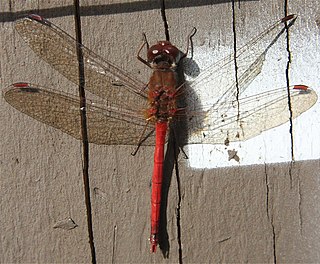
Sympetrum vicinum, the yellow-legged meadowhawk or autumn meadowhawk, is a member of the Libellulidae family and grows to 26–35 mm long.

Aeshna affinis, the southern migrant hawker or blue-eyed hawker, is a dragonfly found in southern Europe and Asia. It is in the family Aeshnidae and is very similar in appearance to A. mixta.

The neon skimmer is a dragonfly of the skimmer family. It can be found near ponds, lakes and slow moving streams in the southwest United States, Central America, and northern South America.
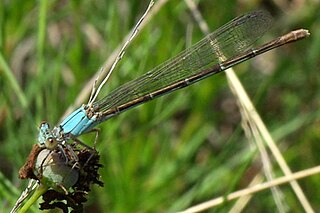
The powdered dancer is a damselfly of the family Coenagrionidae. It is native to North America. It may be seen year-round in at least some of its range.

Eastern forktail is a member of the damselfly family Coenagrionidae.

The desert whitetail is a species of dragonfly in the family Libellulidae. P. subornata is often put into the genus Libellula.

Lestes dryas is a species of damselfly in the family Lestidae, the spreadwings. Its common names include emerald spreadwing, scarce emerald damselfly and robust spreadwing. An alternate name in Ireland is the turlough spreadwing.
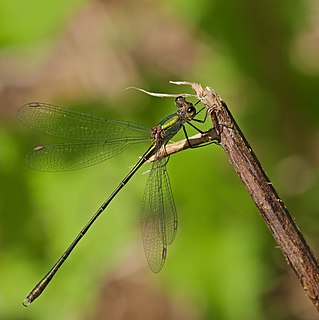
Chalcolestes viridis, formerly Lestes viridis, is a damselfly of the family Lestidae. It has a metallic green body and at rest it holds its wings away from its body. Its common name is the willow emerald damselfly or the western willow spreadwing.

Austrolestes colensonis, commonly known as the blue damselfly, is a species of damselfly of the family Lestidae. It is endemic to New Zealand and can commonly be found throughout the country, and at any time of the year. It is New Zealand's largest damselfly, and only blue odonate.
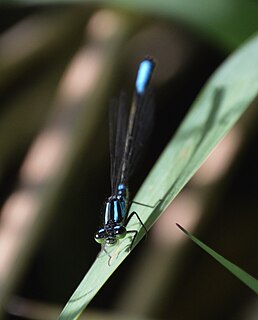
Ischnura erratica, the swift forktail, is a species of damselfly in the family Coenagrionidae. It is native to the Pacific Northwest, ranging from British Columbia to northern California.

Paracercion calamorum, the dusky lilly-squatter, is a species of damselfly in the family Coenagrionidae. It has a range that extends from southern far-eastern Russia to Japan, and to India and Indonesia. The nominate subspecies P. c. calamorum is known from central and eastern China, Korea and Japan. The subspecies P. c. dyeri occurs in southern China, Hong Kong, Taiwan, Indonesia, India, Nepal, and Thailand.
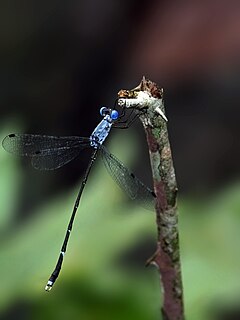
Lestes dorothea or Forest Spreadwing is a damselfly species in the family Lestidae. It is distributed from south and northeast India to Thailand and Malaysia.




















